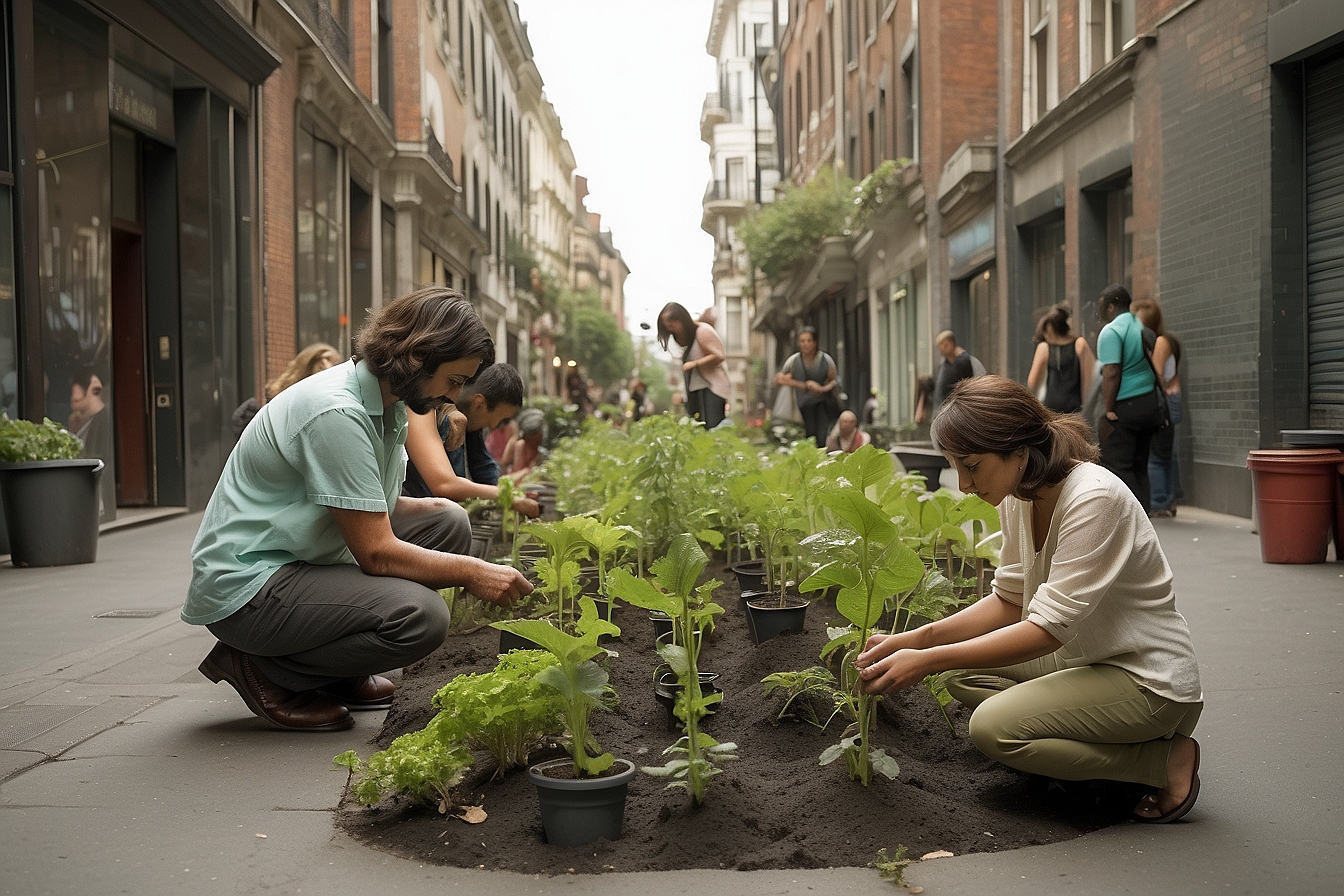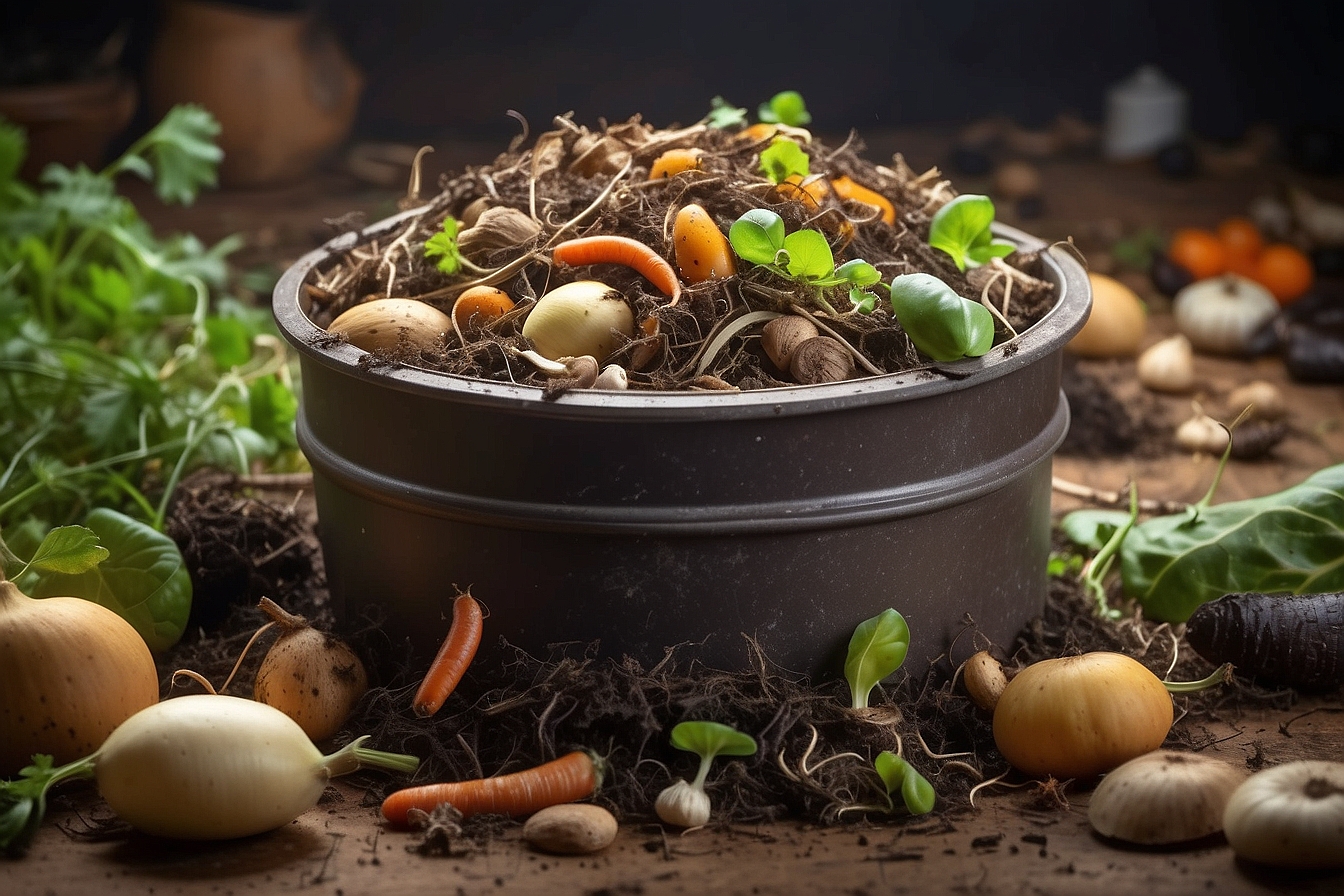Gardening truly is a delicate dance with nature—caring for our little patches of earth while striving to tread lightly upon it. We understand the conundrum all too well, that urge to nurture our gardens whilst being guardians of the environment.
Our guide has been crafted with this very ethos in mind, offering straightforward yet impactful eco-friendly practices that ensure your garden not only flourishes but does so responsibly.
So roll up your sleeves—it’s time to cultivate sustainability in your corner of the world!
Key Takeaways
- Begin your eco – friendly gardening by enriching the soil with compost and organic matter, which supports biodiversity and improves soil health.
- Opt for native plants that are resilient to local climate conditions, require less water, and help sustain local wildlife like bees and butterflies.
- Reduce chemical usage in your garden by employing natural pest control methods such as neem oil or introducing beneficial insects like ladybugs.
- Conserve water through practices like using mulch to maintain moisture, setting up rain barrels for irrigation, or opting for drought-resistant plant species.
- Embrace sustainable materials and creative gardening techniques such as recycled decor or companion planting to enhance both the beauty and eco-friendliness of your garden.
The Benefits of Eco-Friendly Gardening
Eco-friendly gardening offers sustainable use of resources and reduces environmental impact, making it beneficial for both the garden and the planet. By minimising chemical use and providing habitat for wildlife, eco-friendly gardening helps to create a healthier, more balanced ecosystem.
Sustainable use of resources
We know the importance of treating Earth’s bounty with respect. That’s why we advocate for sustainable use of resources in our gardens. Using natural materials, like untreated wood for raised beds and bamboo stakes, supports conservation efforts and reduces our carbon footprint.
We also focus on water conservation through methods like rainwater harvesting and drip irrigation to keep our plants hydrated without waste.
Harnessing ecoconscious gardening practices such as composting kitchen scraps transforms waste into valuable nutrients for your soil. By adopting these earthfriendly techniques, we nurture a home garden that not only thrives but also gives back to the planet in every little way it can.
Let’s now explore even smaller environmental impacts by turning to nature itself – welcoming bees, butterflies, and birds into our green spaces.
Lesser environmental impact
By choosing eco-friendly gardening, we reduce our environmental impact. Using fewer chemicals and opting for natural alternatives supports a healthier ecosystem. Embracing sustainable practices like composting and planting native species creates a balanced environment in which wildlife can thrive.
Prioritising water conservation and selecting materials wisely contribute to reducing our carbon footprint while creating an aesthetically pleasing garden that benefits the wider environment.
When we aim for lesser environmental impact in our gardening efforts, we make a positive contribution to combating climate change and supporting biodiversity. Creating a landscape that works with nature instead of against it leads to long-term benefits for both the environment and ourselves.
Tips for Beginner Eco-Friendly Gardening
When starting your eco-friendly gardening journey, focus on enriching the soil with compost and organic matter. Choose plants that are native to your area and require less water and maintenance, and minimise chemical use by opting for natural pest control methods.
Start with the soil
When starting an eco-friendly garden, begin with the soil. Healthy soil is the foundation for a thriving garden and plays a crucial role in sustainable gardening practices. By enriching the soil with compost and organic matter, you can promote biodiversity, improve drainage, and enhance nutrient levels.
Choosing the right plants that are well-suited to your local soil conditions will also contribute to the overall health of your garden. Additionally, incorporating native plants can further support the ecosystem by providing habitat for beneficial wildlife such as pollinators.
By focusing on nurturing your soil and selecting suitable plant varieties, you will lay a strong groundwork for a successful eco-friendly garden.
Choose the right plants
Select plants that are well-suited to your local climate and soil conditions. Research native species, which are more resilient and adaptable to your area, requiring less water and maintenance.
Opt for drought-resistant varieties to reduce water usage in your garden. Consider planting perennials as they return year after year, promoting sustainable growth without the need for replanting.
Look for plants that attract pollinators like bees and butterflies, contributing to the local ecosystem’s health by providing food sources for these essential creatures.
Reduce chemical use
Minimise chemical use in gardening by opting for natural pest control methods. Use neem oil or diatomaceous earth to deter pests without harming the environment. Introduce beneficial insects like ladybirds and lacewings to keep harmful bugs at bay, without resorting to chemical pesticides.
Switch to organic fertilisers such as compost, manure, or seaweed extract, which enrich the soil naturally and are less harmful to wildlife.
Consider using mulch as a barrier against weeds instead of herbicides; it conserves moisture and improves soil health while avoiding harsh chemicals. Cultivate a healthy ecosystem within your garden by attracting beneficial insects and birds that act as natural predators for pests.
Provide habitat for wildlife
Creating a wildlife-friendly habitat in your garden is crucial for supporting biodiversity. Planting native flowers, shrubs, and trees can provide food and shelter for birds, insects, and small mammals.
Installing a birdbath or bird feeder can also attract various bird species to your garden. Additionally, leaving leaf litter and fallen branches undisturbed can create natural hiding spots for wildlife.
By incorporating these wildlife-friendly features into your eco-friendly garden, you can contribute to the conservation of local flora and fauna.
Sustainable Practices for Gardening
We will discuss composting, the use of native plants, and water conservation techniques. To learn more about sustainable gardening practices, keep reading!
https://www.youtube.com/watch?v=i3gr2gVLggo
Composting
Composting is a simple yet effective way to reduce waste and enrich your garden’s soil. By recycling food scraps, yard trimmings, and other organic materials through composting, you can create nutrient-rich soil additive for your garden.
This practice not only reduces the amount of waste sent to landfills but also helps in improving soil health and promoting plant growth. Composting is an essential part of eco-friendly gardening and supports sustainable use of resources as well as environment conservation efforts.
Implementing composting techniques contributes to climate-friendly gardening practices by reducing greenhouse gases emitted from landfills while increasing the carbon content in the soil.
Native plants
When considering sustainable practices for gardening, native plants play a crucial role. These plants are well-adapted to the local climate, soil conditions and wildlife, making them low-maintenance and beneficial for the environment.
By incorporating native plants into your garden, you can conserve water, reduce the need for chemical inputs, and provide essential habitats for local wildlife. Additionally, native plants contribute to biodiversity conservation and help address issues related to climate change.
Native plants offer an array of benefits in eco-friendly gardening. When introduced into a garden setting they restore balance to ecosystems by providing food sources and supporting pollinators such as bees and butterflies.
Water conservation
When considering eco-friendly gardening, water conservation is a crucial aspect. We can reduce water consumption by using mulch to retain moisture, installing a rain barrel to collect and store rainwater for later use in the garden, and incorporating drought-resistant plants that require less watering.
Additionally, drip irrigation systems can efficiently deliver water directly to plant roots while minimising waste. These practices not only conserve water but also promote sustainable gardening and help protect the environment.
By implementing these strategies, we ensure that our gardens thrive while being mindful of our impact on the planet. Using sustainable gardening techniques like water conservation supports the well-being of our local ecosystems and contributes to a more eco-friendly approach overall.
How to Make Your Garden Eco-Friendly
– Choose sustainable materials like recycled or upcycled items for your garden furniture and decor.
– Experiment with companion planting to naturally repel pests and improve soil health.
Use sustainable materials
When making your garden more eco-friendly, it is important to use sustainable materials. These can include items such as recycled wood for building raised beds, environmentally friendly mulch made from biodegradable materials, or natural stone pathways that have been responsibly sourced.
By using sustainable materials, you reduce the environmental impact of your gardening practices and contribute to a healthier ecosystem for wildlife.
In addition to being better for the environment, using sustainable materials also helps create an aesthetically pleasing garden space. Whether it’s using reclaimed materials for creative DIY projects or opting for organic and biodegradable products, choosing sustainable materials can enhance the overall look and feel of your eco-friendly garden while promoting environmental responsibility.
Try companion planting
When planning your eco-friendly garden, consider trying companion planting. This technique involves growing different types of plants together to benefit each other. For example, planting marigolds alongside tomatoes can help repel pests that commonly affect tomato plants, reducing the need for chemical pesticides.
Similarly, growing aromatic herbs like basil near vegetables can deter pests and attract pollinators, promoting a healthier garden ecosystem.
Companion planting not only supports biodiversity in your garden but also minimises the use of harmful chemicals and fosters natural pest control. It’s an easy and effective way to create a more sustainable and environmentally friendly garden while reaping the benefits of healthier plants and higher yields.
Conclusion
Transitioning to eco-friendly gardening may seem daunting at first, but the benefits make it worth the effort. Sustainable practices not only benefit the environment but also promote healthier and more vibrant gardens.
By implementing these beginner-friendly tips and sustainable practices, you can play a part in creating a greener and more balanced ecosystem for all. So grab your gardening tools and start your journey towards an eco-friendly garden today!
FAQs
1. What is eco-friendly gardening?
Eco-friendly gardening is all about growing plants in ways that are good for the environment, using earthfriendly techniques like organic gardening and ecological landscaping.
2. How can I start an environmentally conscious garden?
To start an environmentally conscious garden, begin with green thumb techniques such as composting, choosing native plants, and avoiding chemical pesticides to create a climatefriendly space.
3. Why should I practice eco-friendly landscaping?
Practicing eco-friendly landscaping helps protect nature by using less water, creating habitats for wildlife, and reducing your carbon footprint through sustainable methods.
4. Can green gardening save me money?
Yes! Green gardening practices like making your own compost or collecting rainwater can cut costs while also benefiting the planet.
5. Are there specific plants that are better for eco-friendly gardens?
Organic and native plants are typically best for eco-friendly gardens because they require fewer resources to grow and support local ecosystems.





